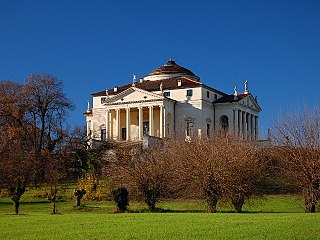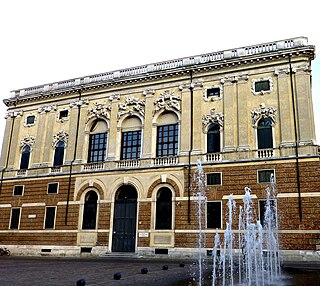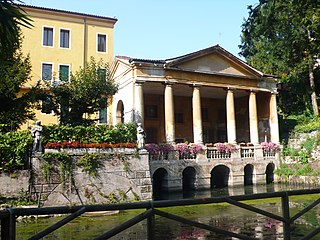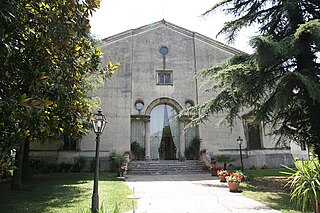
Giovanni Battista Tiepolo, also known as GiambattistaTiepolo, was an Italian painter and printmaker from the Republic of Venice who painted in the Rococo style, considered an important member of the 18th-century Venetian school. He was prolific, and worked not only in Italy, but also in Germany and Spain.

Andrea Palladio was an Italian Renaissance architect active in the Venetian Republic. Palladio, influenced by Roman and Greek architecture, primarily Vitruvius, is widely considered to be one of the most influential individuals in the history of architecture. While he designed churches and palaces, he was best known for country houses and villas. His teachings, summarized in the architectural treatise, The Four Books of Architecture, gained him wide recognition.

Villa La Rotonda is a Renaissance villa just outside Vicenza in northern Italy designed by Italian Renaissance architect Andrea Palladio, and begun in 1567, though not completed until the 1590s. The villa's official name is Villa Almerico Capra Valmarana, but it is also known as "La Rotonda", "Villa Rotonda", "Villa Capra", and "Villa Almerico Capra". The name Capra derives from the Capra brothers, who completed the building after it was ceded to them in 1592. Along with other works by Palladio, the building is conserved as part of the World Heritage Site "City of Vicenza and the Palladian Villas of the Veneto".

Giovanni Domenico Tiepolo was an Italian painter and printmaker in etching. He was the son of artist Giovanni Battista Tiepolo and elder brother of Lorenzo Baldissera Tiepolo.

Pietro Testa (1611–1650) was an Italian High Baroque artist active in Rome. He is best known as a printmaker and draftsman.

The Palazzo Chiericati is a Renaissance palace in Vicenza, designed by Andrea Palladio.

Altavilla Vicentina is a town and comune in the province of Vicenza, Veneto, northern Italy. It is located southwest of Vicenza.
Bolzano Vicentino is a city and comune in the province of Vicenza, in the northern Italian region of Veneto. It lies east of the A31 highway, with a population of 5,455.

Montecchio Maggiore is a town and comune in the province of Vicenza, Veneto, Italy. It is situated approximately 12 kilometres west of Vicenza and 43 km east of Verona; SP 246 provincial road passes through it.

Monticello Conte Otto is a town and comune in the province of Vicenza, Veneto, Italy. It is east of the SP248 provincial road.

Giovanni Antonio Fasolo (1530–1572) was a late Renaissance Italian painter of the Venetian school, active in Vicenza and surroundings.

The Villa Valmarana is a Renaissance villa situated in Lisiera, a locality of Bolzano Vicentino, province of Vicenza, northern Italy. Designed by Andrea Palladio, it was originally built in the 1560s for the Valmarana family.

Palazzo Valmarana is a palace in Vicenza. It was built by Italian Renaissance architect Andrea Palladio in 1565 for the noblewoman Isabella Nogarola Valmarana. Since 1994 it is part of the UNESCO World Heritage Site "City of Vicenza and the Palladian Villas of the Veneto".
Villa Valmarana may refer to several Venetian villas which belonged to the Valmarana family:

Santa Corona is a Gothic-style, Roman Catholic church located in Vicenza, region of Veneto, Italy. The church contains the Valmarana chapel, whose design is attributed to the Renaissance architect Andrea Palladio. Palladio himself was initially buried in this church.

Francesco Muttoni was an Italian architect, engineer, and architectural writer, mainly active near Vicenza, Italy.

The Valmarana family is an aristocratic family in Vicenza, one branch of which also held Venetian patrician status. Its motto was "Plus Ultra" (Further). They were named after the village of Valmarana in the Berici Hills, where they held fiefs from the bishop of Vicenza.

The Loggia Valmarana located inside the Salvi gardens, also called Valmarana Salvi gardens, was probably built in 1591 by a student of Andrea Palladio by the will of Gian Luigi Valmarana himself, who wanted this place become a meeting point between intellectuals and academics.


















